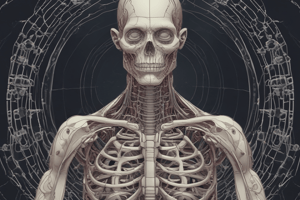Podcast
Questions and Answers
What is the primary difference between fibrosis and regeneration in wound healing?
What is the primary difference between fibrosis and regeneration in wound healing?
- Regeneration can only occur in certain tissues, while fibrosis can occur in any tissue.
- Fibrosis involves the formation of scar tissue, while regeneration restores normal tissue structure. (correct)
- Fibrosis is more effective than regeneration in restoring function.
- Fibrosis occurs faster than regeneration.
Which hormone is primarily produced by the pancreas and regulates blood sugar levels?
Which hormone is primarily produced by the pancreas and regulates blood sugar levels?
- Cortisol
- Insulin (correct)
- Adrenaline
- Glucagon
What is the role of hemoglobin regarding pH regulation in the blood?
What is the role of hemoglobin regarding pH regulation in the blood?
- It regulates the production of bicarbonate ions.
- It releases oxygen in acidic environments.
- It prevents the formation of lactic acid.
- It acts as a buffer by binding to carbon dioxide and hydrogen ions. (correct)
Which structure is primarily responsible for initiating action potentials in the heart?
Which structure is primarily responsible for initiating action potentials in the heart?
Which cranial nerve is primarily responsible for controlling vision?
Which cranial nerve is primarily responsible for controlling vision?
Flashcards are hidden until you start studying
Study Notes
Nitrogenous Bases of RNA and DNA
- DNA contains adenine (A), thymine (T), cytosine (C), and guanine (G).
- RNA includes adenine (A), uracil (U), cytosine (C), and guanine (G).
- A pairs with T (or U in RNA), and C pairs with G in both nucleic acids.
Wound Healing - Fibrosis vs Regeneration
- Fibrosis involves scar tissue formation and can lead to loss of function.
- Regeneration restores original tissue structure and function without scarring.
- Fibrosis primarily occurs in tissues with limited regenerative capacity.
Action Potentials
- Generated by the movement of ions across a cell membrane.
- Involves depolarization (Na+ influx) followed by repolarization (K+ efflux).
- Action potentials are essential for neuron communication and muscle contractions.
Labeling Conduction System of Heart
- Key components include the sinoatrial node (SA node), atrioventricular node (AV node), bundle of His, and Purkinje fibers.
- SA node acts as the natural pacemaker, initiating heartbeats.
- The conduction system ensures coordinated cardiac muscle contraction.
Labeling Eye
- Major components include the cornea, iris, retina, lens, and optic nerve.
- Retina contains photoreceptor cells (rods and cones) that detect light.
- The lens adjusts focus for distant and near vision.
Hormones and Endocrine Glands
- Major endocrine glands include the pituitary, thyroid, adrenal, and pancreas.
- Hormones regulate various body functions, including metabolism, growth, and mood.
- Examples include insulin (from the pancreas) and thyroid hormones.
Structures of the Heart
- The heart has four chambers: left atrium, left ventricle, right atrium, right ventricle.
- Valves include the atrioventricular (mitral and tricuspid) and semilunar (aortic and pulmonary) valves.
- The myocardium is the muscular layer responsible for heart contractions.
Hemoglobin as a Buffer
- Hemoglobin can bind to hydrogen ions, helping to maintain blood pH.
- Acts as a transport molecule for oxygen and carbon dioxide in the blood.
- Helps in regulating acid-base balance in the body.
Rh Factor
- Rh factor is an antigen present on red blood cells, determining blood type (Rh positive or negative).
- Important in pregnancy and blood transfusions; Rh incompatibility can lead to hemolytic disease.
- The discovery of Rh factor enhanced understanding of immune responses.
ECG
- Electrocardiogram (ECG) measures the electrical activity of the heart.
- Shows different waves: P wave (atrial depolarization), QRS complex (ventricular depolarization), T wave (ventricular repolarization).
- Used to diagnose heart conditions and monitor cardiac activity.
Inflammation
- A biological response to harmful stimuli, involving immune activation and tissue repair.
- Signs include redness, heat, swelling, pain, and loss of function.
- Can be acute (short-term) or chronic (long-lasting).
All Pathways for Pain
- Pain pathways involve nociceptors, which detect harmful stimuli and transmit signals to the central nervous system.
- The spinothalamic tract is a major pathway for transmitting pain and temperature information.
- Chronic pain can stem from neuropathic and inflammatory sources.
Cranial Nerves
- There are twelve pairs of cranial nerves, each with specific functions (sensory, motor, or both).
- Notable nerves include the optic (vision), olfactory (smell), and vagus nerve (autonomic functions).
- Cranial nerves play crucial roles in sensory perception and motor control.
Functions of the Structures of the Ear
- The outer ear (pinna) collects sound waves.
- The middle ear (ossicles) transmits vibrations to the inner ear.
- The cochlea (inner ear) converts sound waves into electrical signals for the brain.
Blood Cells and Their Functions
- Red blood cells (erythrocytes) transport oxygen and carbon dioxide.
- White blood cells (leukocytes) are part of the immune system, fighting infections.
- Platelets (thrombocytes) play a key role in blood clotting.
Functions of the Structures of the Eye
- The cornea refracts light, focusing it on the retina.
- The iris controls the amount of light entering the eye.
- The optic nerve transmits visual information to the brain.
Systemic and Pulmonary Circuits
- Systemic circuit distributes oxygenated blood from the heart to the body.
- Pulmonary circuit transports deoxygenated blood from the heart to the lungs for oxygenation.
- Both circuits are essential for maintaining oxygen and nutrient delivery.
Specific Immunity
- Involves adaptive immune responses, characterized by specificity and memory.
- Primary cells include T cells (cell-mediated immunity) and B cells (antibody-mediated immunity).
- Acquired through exposure to pathogens or vaccinations.
Hemostasis
- The process of blood clotting to prevent excessive bleeding.
- Involves three stages: vascular spasm, platelet plug formation, and coagulation cascade.
- Key players include platelets, clotting factors, and blood vessels.
Studying That Suits You
Use AI to generate personalized quizzes and flashcards to suit your learning preferences.



